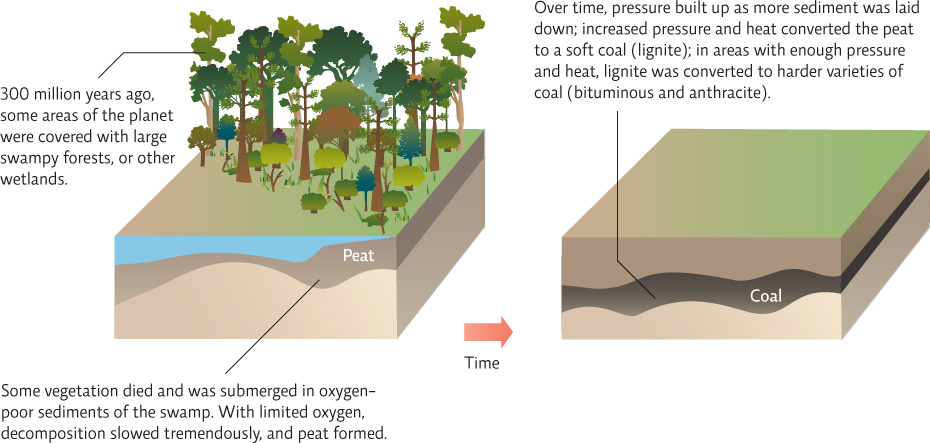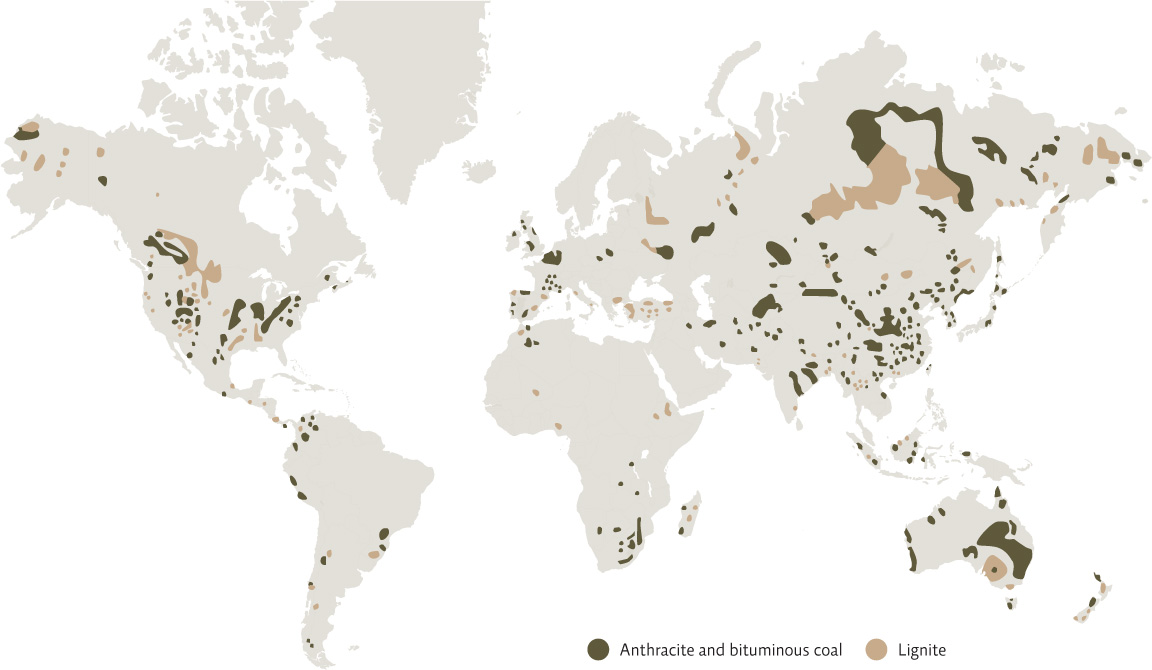Coal forms over millions of years.
The Appalachian Mountains were born a few million years before the rise of the dinosaurs, when Greenland, Europe, and North America hovered near the equator as a single giant landmass bathed in a dense tropical swamp. The northwestern bulge of what is now Africa pressed into the easternmost edge of North America, pulverizing the colliding continental margins and forcing a colossal mass of land upward, into a mountain range as high as the Himalayas. It was the last and greatest of three violent clashes that joined all the world’s land into a single supercontinent, upon which stegosauruses and velociraptors would eventually roam.
KEY CONCEPT 18.2
Coal is a fossil fuel, formed over long periods of time when dead plant material was buried and subjected to high heat and pressure.
The fallout from this cataclysm—the gradual accretion of decomposing swamp vegetation compressed and baked by heat and time—established the Appalachian coal beds. As the swamp plants died out, they were buried under a mud so thick it kept oxygen out. Instead of being fully decomposed by bacteria, their remains produced peat—a soft mash of partially decayed vegetation. As time passed and more and more layers of sediment were laid down over the peat, pressure and heat compressed it into the denser rocklike material that we know as coal. INFOGRAPHIC 18.2
Coal is formed over long periods of time as plant matter is buried in an oxygen-poor environment and subjected to high heat and pressure. Places with substantial coal deposits that are retrievable with current technology are called coal reserves.


Peat is found in many areas of the world today, such as the peat forests of Indonesia and the peat bogs of Ireland. Will this peat eventually turn into coal?
Given enough time, if the peat becomes buried under sediments, deep enough to be exposed to high heat and pressure, then it could be converted to coal. But this process takes a long time - both for enough sediments to accumulate to provide the pressure and heat needed, and the time it takes for the chemical conversion to take place once the peat is buried deep enough.
This same story—tectonic upheaval followed by deep and rapid burial of organic material, followed by the material’s slow compaction into coal—has played out in numerous places around the globe. As a result, coal is found everywhere, though of course some places have more than others. Europe and Eurasia hold about 35% of the world’s reserves, while the Asian Pacific has about 32%, and North America holds 27.5%. The United States has more coal than any other country with almost 27% of the world’s total reserves, followed by Russia (18%) and China (13%). INFOGRAPHIC 18.3
Coal reserves are not evenly distributed around the world. The United States has 28% of the world’s coal reserves, with much of its best, low-sulfur bituminous, coal found in Appalachia.


Why aren’t coal reserves found everywhere?
Coal reserves are only found in areas where the swampy areas that provided the organic material were located.
The Appalachian beds were once among our most bountiful reserves; seams as tall as a man wound for miles through the mountainside and made for easy harvesting. But after 150 or so years of mining, those reserves have dwindled noticeably. At current rates of usage, proven coal reserves (those we know are economically feasible to extract) should last about 120 years—longer if deeper reserves can be accessed. And as the layers of minable coal have grown thinner and harder to reach, the coal industry has become both more sophisticated and more destructive in its approach to extracting the coal.
KEY CONCEPT 18.3
Coal deposits are located throughout the world, though some areas have a larger supply than others.